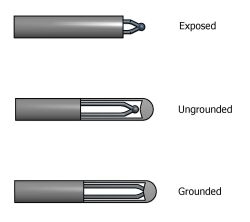Shop by Category
Selecting Your Junction Type
Selection of the Measuring Junction
Sheathed thermocouples are available in 3 junction types: grounded, ungrounded, and exposed. Each design offers specific advantages as well as disadvantages and must be considered carefully when placing an order.

Grounded Junction
The thermo-elements are welded into the end cap using the same weld rod as the sheath material. Fast time response. Recommended
for high pressure applications, liquids, moisture, contaminating atmospheres, and most general uses.

Disadvantage: Can Be subject to EMF interference.
Ungrounded Junction
The thermo-elements are welded together and are electrically isolated from the sheath. Recommended for applications where stray EMF's from electrical apparatus would affect the reading.

Disadvantage: Slower Response Time.
Exposed junction
The thermo-elements are welded together outside of the sheath. This provides the fastest time response, but exposes the elements to contamination. Electrically isolated from the sheath. 
Disadvantage: Cannot be used in an environment with a high percentage of solids, high pressure, or liquid material since the junction is exposed to this environment.
Response times
Values are for 2/3 of total temperature change from 0 to 100% as measured in water. 20-AWG bare wire junction measured in gas.
| Outside Diameter | Approximate Wire Gauge | Approximate Wall Thickness | Grounded Junction | Ungrounded Junction |
| .020 | 38 | .003 | .02 | .03 |
| .032 | 34 | .004 | .02 | .07 |
| .040 | 32 | .006 | .04 | .13 |
| .062 | 28 | .009 | .22 | .40 |
| .090 | 25 | .012 | .33 | .68 |
| .125 | 22 | .017 | .50 | 1.10 |
| .188 | 19 | .025 | 1.00 | 2.30 |
| .250 | 16 | .033 | 2.20 | 4.10 |




